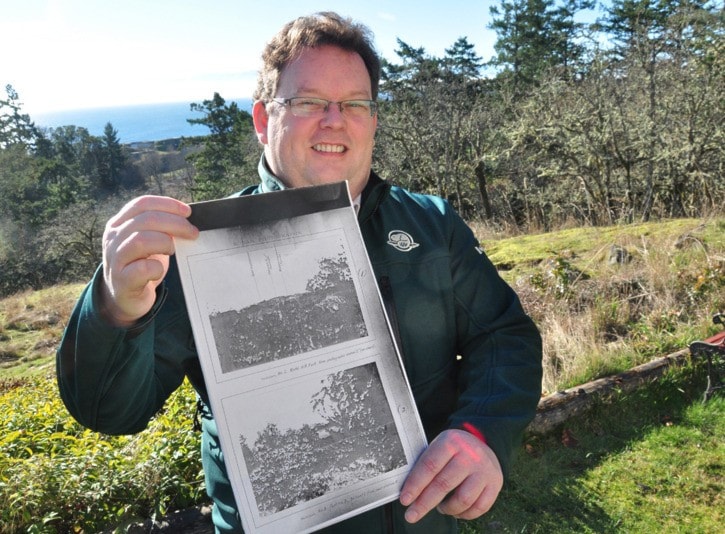Espionage from 1897 gives Fort Rodd Hill new insights into its past
Hiring a few horses and armed with a large glass-plate camera and sketch pad, in 1897 a visiting U.S. military officer quietly made his way to the outskirts of Victoria.
In what were forests and farmland of the western communities, he found a vantage point overlooking the ongoing construction of Fort Rodd Hill in Colwood. The officer took slide after slide of photos, scribbled notes, sketched what he saw and tried to keep a low profile.
This was espionage in the colonial era. Britain, in co-operation with Canada, was constructing two heavily fortified, heavily armed bases at the mouth of Esquimalt harbour, home of the British Royal Navy’s Pacific squadron.
Fort Rodd Hill historic site manager Dave King says officers photographing or sketching foreign ports was standard procedure back then, but at least two U.S. military officers approached the task of documenting Fort Rodd Hill and Fort Macaulay (now Macaulay Point) with exceptional vigor.
“We had a real incident with a U.S. army spy,” King says, standing outside the administration house overlooking the fort, holding a photocopied image from 115 years ago that offers a similar view to today. "The officer sat right on this hill ... in 1897 and sketched and photographed the fort under construction."
Lieut. Andrew Summers Rowan, of the U.S. 19th infantry, and Lieut. DF Sellers, a U.S. navy intelligence officer, both offered detailed assessments on fortifications, defences and weaknesses of Fort Rodd Hill.
The officers were frank in their reports about avoiding detection. Rowan had a hard time estimating the caliber of the hidden guns and said the fort was in a strong strategic location, but surmised it wouldn’t be a match against U.S. warships.
“I have been very fortunate in having been enabled to gather, unobserved, data relating to the location, method of construction the number of emplacements and the number of guns,” wrote Rowan, in a 1897 report to the War Department in Washington.
“Great secrecy is observed in the construction ... My method was to occupy coigns of vantage and seize opportune moments to gather what I learned of the fortifications.”
Complete with photocopied photographs and hand sketches, the espionage reports landed on King's desk a few years ago. They paint a previously unknown picture of the historic site and offer a stark reminder that the fort, shut down in 1956, was once viewed an powerful West Coast military asset.
King noted that at the time, Canada and Britain viewed the U.S. as the main military threat to British Columbia and Western Canada, although Britain was also experiencing tensions with Russia.
“When this fort was being built, 1897 was an interesting period. Coast artillery was seen as a secret, but you wanted everyone to know the fort was here for deterrence,” King says. “But you didn’t want anyone to know how big the guns were.”
Rowan's report indicates he hired a rowboat and oarsman, and audaciously snapped photos of the fort and Fisgard Lighthouse, in broad daylight, from Esquimalt harbour.
Hauling a large camera with plate-glass slides and a tripod into a small open boat somehow didn’t draw the attention of military sentries, and there is no evidence either agents were caught.
“This guy hired a rowboat around Macaulay Point (and Fort Rodd) and reported about the guns, the defences and the whole nine yards,” King says, showing an U.S. military image of Fisgard Lighthouse without its causeway. “In the 1890s you were expected to do that, but one guy was exceptionally energetic. Apparently he was not caught. That would have made the news.”
King received the reports and photographed images, stamped with the “U.S. Army Military History Institute,” in the mail a after a retired U.S. military archivist visited Fort Rodd Hill.
“We had an American visitor who was an expert in coastal artillery take a tour of the site. A few months later the documents showed up in an envelope in the mail,” King says. “It blew us away. We all just said ‘wow.’”
Colonial-era spying has inspired a free activity at Fort Rodd, where kids (or adults) can use a GPS unit to go on missions and find “secret” information about the fort – learning disguised as spy craft.
King is trying to track down high-resolution digital images of the 1897 military photos and drawings to help round-out a potential public display about espionage at the fort.
"People don't think about this kind of thing happening around here. It's kind of a hidden history."
The images will also give fort historians rare access to details and nuances of the construction process and early history of Fort Rodd Hill. British records and images, if they still exist, reside in London.
“We are learning more about building this fort from American spying than British records,” observed Fort Rodd Hill historic interpreter Bob Campbell. “We hope we can do something with this information (for the public).”
“This material is extremely valuable,” agreed King. “We have no photos during the building period, so this stuff is exceptionally interesting for us.”
editor@goldstreamgazette.com
